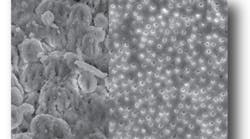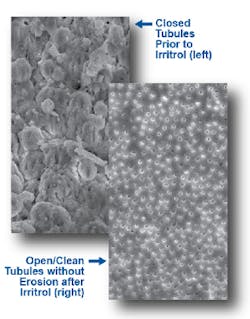This procedure will optimize bacterial reduction, reduce instrument resistance to full apical preparations, and ultimately preserve dentin in the latter stages of shaping.
This article first appeared in the newsletter, DE's Breakthrough Clinical with Stacey Simmons, DDS. Subscribe here.
Proper cleansing of endodontically treated canals requires the constant use of irrigants throughout the entire instrumentation procedure. A clear understanding of the irrigants, their concentration, and sequence will do much to help the dentist improve his or her endodontic treatment success rates.
While many irrigants are available, the three main ones used most prominently in endodontics are sodium hypochlorite, EDTA, and chlorhexidine. They can be used in a variety of concentrations. Sodium hypochlorite is used in concentrations from 0.5% up to 6%. Since its tissue-digesting potential is directly related to its concentration, I prefer to use this irrigant at the highest concentration of 6%. Higher concentrations soften the dentin, but considering the fact that softening the dentin makes its removal easier when shaping the canal, this is a plus.
ALSO BY DR. BARRY MUSIKANT |Endodontic insight: Maximizing canal cleansing with minimal dentinal weakening
EDTA 15% has been used for years in paste form, but it is difficult to remove prior to obturation. Consequently, I prefer to use it in aqueous form at a concentration of 17%. Its purpose is to remove the smear layer and open the dentinal tubules. In doing so, 17% EDTA allows the sodium hypochlorite to penetrate more deeply into the dentin, further reducing the viable bacterial population.
Chlorhexidine (CHX) 2% is a more recent addition to the irrigant protocol. While NaOCl is antibacterial, it is ineffective against Enterococcus faecalis (E. faecalis), a microorganism associated with unresolved endodontic infections. CHX 2% does a much better job of combating E. faecalis. NaOCl and 2% CHX cannot be used together; when combined, they produce an undesirable precipitate. A precipitate will also form when 2% CHX is combined with 17% EDTA.
Recently, a new product overcame the precipitation problem when formulating CHX and EDTA together. This mix, Irritrol (Essential Dental Systems Inc., South Hackensack, New Jersey), works synergistically to produce a 99.99% kill rate within 30 seconds, making it an ideal final irrigant. Due to Irritrol’s unique chemistry, its 99% kill rate compares to just a 20% kill rate of standard CHX, and it has the added benefit of being far less aggressive in attacking the collagen structure—something you want in this final stage of canal cleansing and shaping.
ALSO BY DR. BARRY MUSIKANT |Endodontic insight: Thorough root canal cleaning and shaping while preserving tooth structure
From my perspective, the dentist is faced with two situations when shaping canals: The pulp is either predominantly vital or nonvital. Nonvital tissue is generally infested with bacteria. The goal is to reduce that bacterial load as quickly as possible, knowing that the process of instrumentation may push some infected debris over the apex. NaOCl 6% is the only irrigant capable of disrupting a bacterial biofilm likely to be present in long-standing infected teeth. In this situation, my first irrigant choice would be 6% NaOCl. This would be followed by 17% EDTA to soften the dentin, remove any smear layer present, and open the dentinal tubules. I would limit the use of the 17% EDTA until the canals are opened to a 20. Then I would recommend substituting Irritrol while still using the 6% NaOCl. We no longer need further softening of the dentin. The glide path has been established and subsequent instruments larger than 20 will routinely negotiate to the apex when using a 30 º to 45º reciprocating handpiece, oscillating at 3,000 to 4,000 cycles per minute.
If the canals have vital tissue in them, I would use 17% EDTA first, rather than 6% NaOCl. NaOCl will make vital tissue more fibrotic and difficult to negotiate through and remove. By using 17% EDTA, the tissue retains its gelatinous state, and it is far easier to negotiate through the canal. I would not add NaOCl until the canals have been shaped to a minimum of 20/02. At that point, I would substitute Irritrol for the 17% EDTA, using it sequentially with 6% NaOCl and with Irritrol being the final irrigant used in the canal.
This is a simple protocol that can be adapted to the various needs of the tooth as determined by the state of the pulp prior to treatment. This procedure will optimize bacterial reduction, reduce instrument resistance to full apical preparations, and ultimately preserve dentin in the latter stages of shaping.
This article first appeared in the newsletter, DE's Breakthrough Clinical with Stacey Simmons, DDS. Subscribe here.








